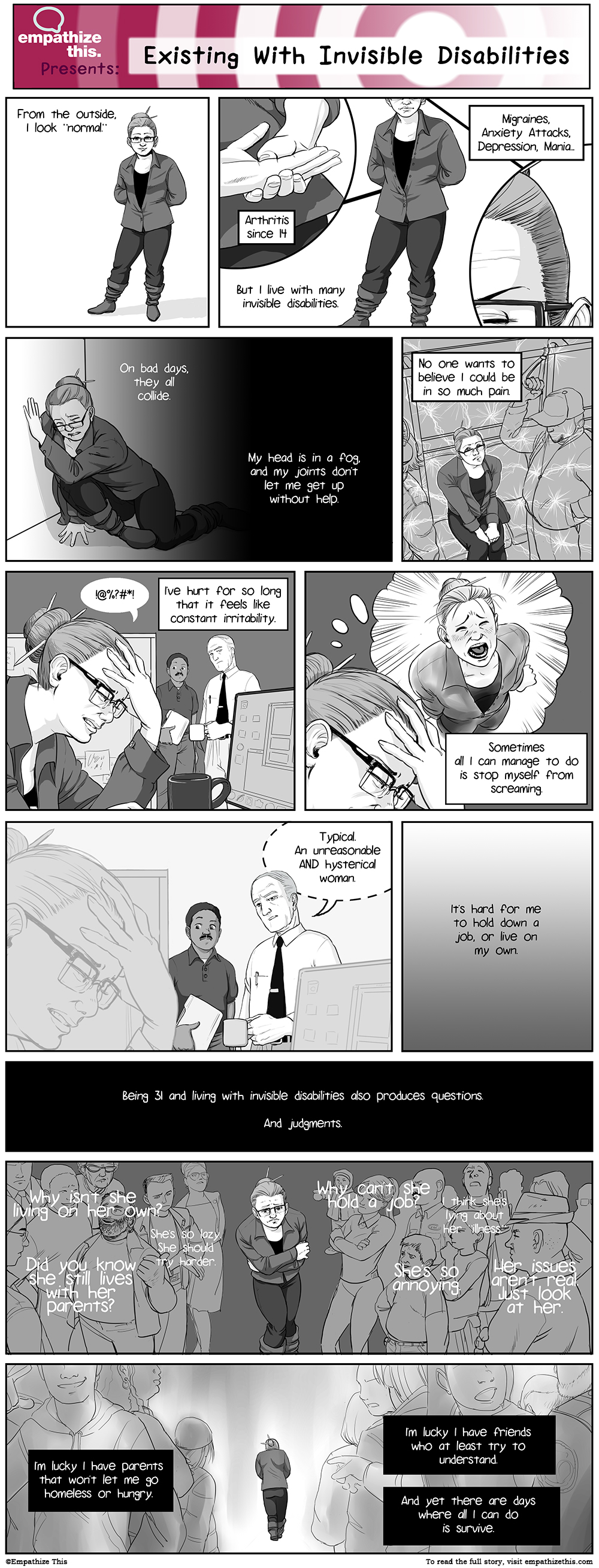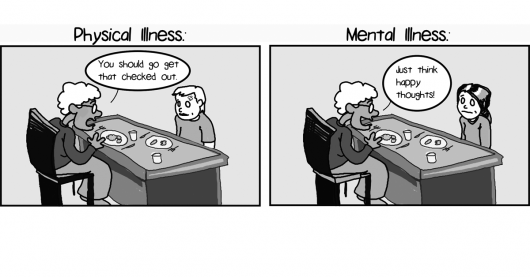Existing With Invisible Disabilities

Existing with Invisible Disabilities
Panel 1
[Image] A woman, standing and looking at the reader. Her hair is pulled back into a bun.
[Caption] From the outside I look “normal.”
Panel 2
[Image] The same image as the first panel, but zoomed in. Two bubbles connected by lines to her head and her hands zoom in even more on those areas.
[Caption] But I live with many invisible disabilities. Arthritis since 14. Migraines, Anxiety Attacks, Depression, Mania.
Panel 3
[Image] The woman, on the floor and leaning against a wall. Her face is in a grimace, and her hand is pushed against the wall, as if to brace for a fall.
[Caption] On bad days, they all collide. My head is in a fog, and my joints don’t let me get up without help.
Panel 4
[Image] The woman, sitting on a bus. Other people on the bus are present in outline, around her. She looks nervous, and is looking upward.
[Caption] No one wants to believe I could be in so much pain.
Panel 5
[Image] The woman, sitting in front of a computer screen. She is wincing and her hand is on her forehead. In the background are two men, looking skeptical.
[Caption] I’ve hurt for so long that it feels like constant irritability.
Woman: !@%?#*!
Panel 6
[Image] The woman, still holding her head. A thought bubble shows an image of herself looking upward and screaming.
[Caption] Sometimes all I can manage to do is stop myself from screaming.
Panel 7
[Image] The same scene with the woman across from her computer screen, but zoomed in to focus on the two men in the background, still looking skeptical.
Man: Typical. An unreasonable AND hysterical woman.
Panel 8
[Caption] It’s hard for me to hold down a job, or live on my own.
Panel 9
[Caption] Being 31 and living with invisible disabilities also produces questions. And judgments.
Panel 10
[Image] The woman, standing and looking very unhappy, hugging herself. She is surrounded by crowds people who are looking at her but giving her a wide berth. The captions are interspersed among the crowd.
[Caption] Why isn’t she living on her own?
She’s so lazy. She should try harder.
Did you know she still lives with her parents?
Why can’t she hold a job?
I think she’s lying about her illness.
She’s so annoying.
Her issues aren’t real. Just look at her.
Panel 11
[Image] The woman walking away from the crowd, shoulders slumped and head down. The crowd is still pointing at her as she leaves.
[Caption] I’m lucky I have parents that won’t let me go homeless or hungry. I’m lucky I have friends who at least try to understand. And yet there are days where all I can do is survive.
Full story
I am 31 and female-bodied. I’ve had ADD all my life. Since puberty hit at 14, I have had progressively worse arthritis and periodic migraines. I also have anxiety attacks, depression, and mania.
I don’t pick up social cues well. Crowds are bad because social cues are harder to pick up on in a high-stress environment. On good days I might manage to make it through without blundering badly – but I’m always worried that I’m missing something.
On bad days, they all collide – I struggle to not feel angry (or at least not to show it), I feel like I’m in a fog, and my joints are so stiff I can’t get up without someone picking me up off the ground.
No one wants to believe that a woman who looks like she’s barely old enough for college – just a girl, just a girl – has chronic and recurring pain. It’s hard for people to believe that I’ve hurt for so long that it no longer registers as pain, but as constant irritability. Sometimes all I can manage to do is stop myself from screaming, yelling, and throwing things.And I can’t show that irritability, because then I’m being unreasonable, I’m being a hysterical female, I’m wrong, wrong, wrong.
Needless to say, it’s hard to hold down a job. My disabilities also make it impossible to live on my own – the longest I’ve managed is a year and a half. I also can’t afford medication, and I can’t even afford to go to the doctor. I certainly can’t afford medical insurance – and there is no public option when you’re living in a household with an income that is supposedly above the poverty line.
But because my disabilities are invisible, I have to deal with questions about why. Why is a woman in her thirties living with her parents, why am I not getting a job, why? And then there are the insults and questions. People think I’m lying about being ill, and that my issues can’t possibly be real. Or people think I’m just not trying hard enough.Sometimes I don’t even need other people to insult me, because they’re all there in the media, in the social expectations. They’re all in my head from hearing them being said to others who can’t pass for normal as well.
I’m lucky I have parents that won’t let me go homeless or hungry. I’m lucky I have friends who at least try to understand. And yet there are days when it’s all I can do just to survive.
This week’s comic was drawn by Devin Parker. You can check out more of his stuff here*

 I Am Struggling But I Am A Person
I Am Struggling But I Am A Person  My Head Injury Was Dismissed as Nothing
My Head Injury Was Dismissed as Nothing  The Stereotype in the Restaurant Industry That Needs to End
The Stereotype in the Restaurant Industry That Needs to End
My god, it’s like this woman is living my life. We don’t have the exact same issues, but so much of this account is as familiar as it would be if I wrote it myself. I’m so sorry and hope she finds more people that understand and don’t judge her.
Thank you for speaking to the very real issue of people with significant illnesses being uninsured and unmedicated and untreated completely. I think people assume that those who are “sick enough” must somehow be already taken care of. They do not include us in their calculus about health insurance. They say that the “disabled already have health insurance,” when that only applies to people who have already succeeded at getting federal disability insurance. Simply having a disability does not give one the legal status of disabled. Often it is necessary to have a lawyer and engage in a lengthy process in order to try to be approved. To provide the necessary evidence, one has to have an ongoing good relationship with a doctor. And again, we are back to the issue with healthcare.
This is spot on. and the comments. I wish more people would understand. Maybe they will some day. and to the guest artist… Devin, you have always been an amazing artist, I’m so glad to see how it’s developed 🙂
Thank you for talking about this. I completely understand, even though I’m only 15. I spent most of my young childhood (started at 4) with an invisible illness. I was shuttled from doctor to doctor, each one less helpful the the last. No one understood why I was taking so many pills and going to so many doctors, because I didn’t “look sick”. It wasn’t until I was 12 that they figured out I had a completely different illness that no one bothered to test for in 8 years. I’m currently “cured”, as in I still have the illness but it isn’t active. But even 3 years later, I have serious control freak issues because I spent most of my childhood completely out of control of my own body and what happened to it. Reading this, it made me feel less alone. But I hate that someone else is still living with such horrible invisible disabilities. Ms, if you see this, I really do wish you the best. I hope you know that you aren’t alone in this respect.
Couldn’t they find a female artist to illustrate this?
It seems that you may not have seen the rest of our site – our resident artist is actually female, and as such most of our comics are illustrated by her. From time to time we have guest artists help us out, since we all work on this at our own time and we often require some help. I’d also like to point out that currently everyone involved in this project provides their expertise at a loss.
Of course, in an ideal scenario we would have each comic drawn by someone who can also identify with the story, and we try to do so whenever we can. In this particular case, being female isn’t the main point of the story. It’s about disabilities, and while we won’t disclose personal information about our illustrators, for all you know the illustrator can actually identify with having disabilities. What matters to us is that the author was perfectly happy with this arrangement. I encourage you to check out our FAQ and About Us section to learn about this project in more detail, which hopefully provides you with more insight about our decision making.
Why does the artist need to be female? Are you suggesting that females are the only ones with invisible disabilities?